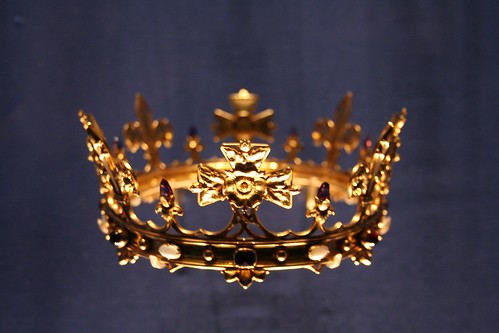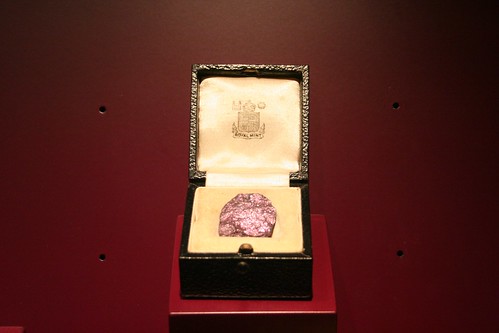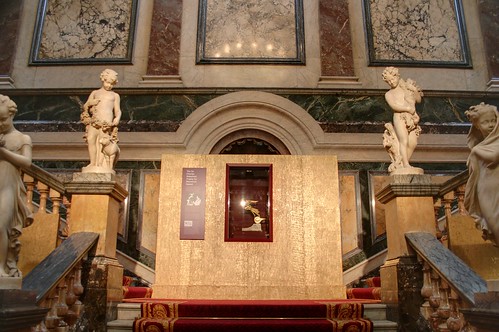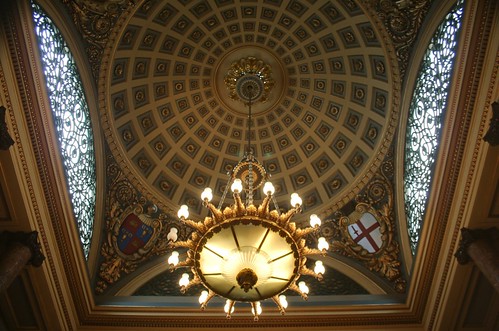Gold – a metal that goes beyond mere physical characteristics to have embedded itself in human imaginations in a way that probably no other metal could, and a new exhibition about this rare metal seeks to appeal to both the mind and the heart.
I say rare, for it is genuinely a rare metal – allegedly the entire global supply would make a cube the size of a cricket pitch. Which makes it rather different from the diamonds often added to gold jewellery – the allure of which is down to clever marketing instead of rarity.
Appropriately, the exhibition is being held in the sumptuous Goldsmith’s Hall just around the corner from St Paul’s Cathedral and is set over two floors. Actually three, but the basement holds just a few items next to the toilets.
It is down here though that one of the more curious exhibits lies. Gold has the ability to be drawn out into slender threads, and here is a ladies hat woven from threads finer than a human hair. Probably more technically impressive than visually so, but certainly something to look out for at Royal Ascot one year.
Obviously gold doesn’t start off as jewellery, so a couple of glass cases by the entrance (and easy to overlook) show gold in its rawest form, including the largest single nugget of gold ever found in the UK.
This is also not just a display of old gold, but new as well, with contemporary gold artisans having some of their work being shown off next to the works of their forefathers.
And a gold bar of the sort they use in bank vaults. Here protected behind glass you can’t touch it, unlike a gold bar in the Bank of England museum that you are able to lift up to feel its shocking weight.
The gold bar though sits above a single coin – a US Double Eagle which the sign says is one of a cache of 80 coins found in Hackney. They were buried in 1940 by the brother of a German Jewish banker. After the war just a single jar was recovered – and then in 2007, the rest were rediscovered.
Gold being that most precious of materials naturally ended up being largely used by Church and State to ornament themselves, but here is also The Stapleford Cup, the earliest secular gold plate surviving – that has been dated to around 1610.
Back to Church and State, there is also one of the oldest surviving pieces of religion/monarchy in the form of the tiny phial of holy oil used to anoint King Charles I when he was crowned.
Gold’s ability to be melted down and recast without losing quality being its greatest asset if you want new ornamentation, and a disaster if you want to look at a display of historic artefacts – as most of them have been melted down.
You can blame a certain King Henry VIII and one Oliver Cromwell for most of that.
Being Olympics year, you can’t escape a display of Olympic medals. It turns out that only four of the modern Olympics offered actual gold medals – they are now silver with gold plate.
One other item which is curious is a small lump of “purple gold” a specially refined metal that is so brittle that it has to be cut more like a jewel than a metal.
As an exhibition this is a vast array of items from lumps of gold, through practical items and decorative to coinage, of which there is quite a bit on display. They say over 400 items have been collected together for the exhibition.
Although there were many things I admired, the display is not lain out with these things being highlighted – so unless you study each glass case in turn you could miss something interesting.
But that is part of the appeal of the display for me – it rewards deep inspection.
About a third of the display is in the grand hallway where the decoration of the halls contrasts with the modern metal work, and then upstairs they have shrouded the building in dark fabrics so that the objects command your attention.
This is a good exhibition – actually, its a very good exhibition, with lots to see from a huge range of history and style.
Oh, and it’s completely free to visit which is a rare pleasure for a display of this size.
The exhibition, “Gold: Power and Allure” runs until 28th July and is open from 10am to 5pm Mon to Sat (except Bank Holidays).
Do admire the roof while you are there.
Some more photos here.













Thanks. Looks well worth a visit.
Oldest surviving secular plate – how about the (probably Neolithic) Ringlemere Cup, or if that is a bit too squashed for you, the Rillaton Cup?